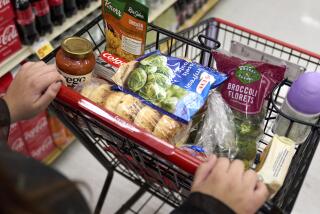Does Social Class Determine What You Eat?
- Share via
A couple of years ago, Yale University researchers came out with a study advocating a “fat tax.” Much of the country laughed.
The measure, designed to lower billowing obesity rates in the United States, would have placed taxes on foods loaded with fat and cholesterol, and subsidized the cost of fruits and vegetables.
Interviewed in 1998, Yale professor Kelly D. Brownell, director of the study, told the Washington Times that people are gaining weight because they are “being blitzed with messages to eat more. . . . Junk-food advertisements should be regulated and excise taxes imposed on high-fat foods, just as they are on tobacco and alcohol.”
In the March issue of Harper’s magazine, writer Greg Critser takes a look at American obesity and concludes that it is social class, not willpower, that will determine whether you are grossly overweight. In “Let Them Eat Fat,” he places much of the blame on fast-food giants, who target the underclass as consumers of their doughnuts, burgers and shakes.
At a Los Angeles hospital, Critser came upon a man being wheeled into intensive care. The man was a 22-year-old who weighed 500 pounds and had undergone two stomach-stapling operations, one of which was coming apart.
The young man, says Critser, “was suffocating in his own fat.”
One-fifth of Americans are obese. About a quarter of Americans younger than 19 are overweight or obese. Childhood obesity has been declared epidemic. Upward of 300,000 people die each year from diet-related conditions.
Consider another sobering statistic: “One of every four hamburgers sold by the good folks at McDonald’s . . . is now purchased by inner-city consumers who, disproportionately, are young black men,’ Critser said. He mentions the marketing strategy of Krispy Kreme, the doughnut franchise, in opening a Los Angeles-area store. Critser asked the manager of the new store why the store was in the heart of the San Fernando Valley’s Latino community.
“The idea is simple,” the manager said. “Accessible but not convenient. The idea is to make the store accessible--easy to get into and out of from the street--but just a tad away from the, eh, mainstream so as to make sure that the customers are pre-sold and very intent before they get here. . . . We want them intent to get at least a dozen before they even think of coming in.”
But why this place? asked Critser. The manager gestured to the overweight women waiting in line outside the store. “We’re looking for all the bigger families. . . . Bigger in size.”
The result of “supersizing,” and the price and promotion wars among fast-food companies has meant higher rates of childhood diabetes, sleep apnea and other diseases.
Critser notes that Eli Lilly & Co., the pharmaceutical concern, is now building a huge factory dedicated solely to the production of insulin, and that its sales of insulin products ($357 million) in the third quarter of 1999 were up 24% from the previous third quarter.
It doesn’t help, Critser writes, that almost no one is willing to confront obesity as a class issue, or that addressing obesity may lead to more cases of anorexia and bulimia. Clothing manufacturers have co-opted chubby consumers by marketing baggy clothes for the hip-hop crowd.
The winners in this national weight-gain? “The ones running and owning the clothing, media, food and drug companies,” Critser writes. “The affluent know that the stuff [fatty food] will kill them, but need someone [else] to eat it so as to keep growing that retirement portfolio.”
It’s easy to blame corporate America for the country’s growing girth, but others are guilty as well: school districts that don’t provide adequate physical education classes, parents who don’t monitor their children’s eating habits, and children themselves, who know deep down that sitting for hours in front of a television cannot be a good thing.
More to Read
Eat your way across L.A.
Get our weekly Tasting Notes newsletter for reviews, news and more.
You may occasionally receive promotional content from the Los Angeles Times.









